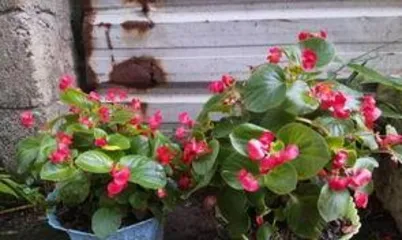I have a pot of Begonia semperflorens at home, and it's incredibly beautiful! Every time I see its vibrant flowers, my mood lifts. However, growing flowers isn't always easy, especially for delicate ones like Begonia semperflorens. Today, let's talk about how to keep your Begonia semperflorens both beautiful and healthy!
Soil: Choosing the Right Soil for Happy Roots
Did you know that Begonia semperflorens isn't too picky about its soil? As long as the soil is loose, fertile, and well-draining, it will thrive. I usually mix leaf mold, sand, and garden soil, which ensures good aeration and provides sufficient nutrients. Of course, don't forget to add some organic fertilizer as a base fertilizer to help the begonia grow more vigorously!
Watering: Water is Life, but Method Matters
Begonia semperflorens likes a humid environment but is not tolerant of waterlogging. So, watering technique is important. I usually water based on the soil's dryness, keeping it slightly moist. In the summer, when it's hot and water evaporates quickly, remember to water more often. In the winter, when it's cold and evaporation is slow, reduce watering. Remember the principle of "watering when dry and moist when wet," and don't let the soil get too dry or waterlogged.
Fertilizing: Balanced Nutrition for Stunning Flowers
Fertilizing is key to a healthy begonia. I usually apply a diluted, liquid fertilizer every 20 days during spring and autumn. Be careful not to over-fertilize, as this can cause fertilizer burn. In the spring, you can use more nitrogen fertilizer to promote leaf and stem growth. In the summer, more phosphorus and potassium fertilizer can encourage flowering.
Light: Abundant Sunlight for Brilliant BloomsBegonia semperflorens loves sunlight but should be protected from direct, intense sun. I usually place it by a south-facing window where it can get plenty of sun. In the summer, when the sun is strong, remember to provide some shade to prevent sunburn.
Pruning: Proper Pruning for Lush BloomsPruning is an important part of begonia care. I usually prune during the growing season, removing diseased, dead, and old branches to maintain good air circulation and light penetration. Additionally, you can pinch the tips of the stems to encourage side branch growth and create a fuller plant with more flowers.
Pests and Diseases: Prevention First, Treatment SecondBegonia semperflorens is susceptible to powdery mildew and spider mites. I regularly check the plants and take action as soon as I notice any pests or diseases. For powdery mildew, you can use a 15% triadimefon solution at 1000 times dilution. For spider mites, you can use a 40% dimethoate emulsion at 600-800 times dilution for spraying.
Caring for Your Begonia: With Love and Care for Beautiful BloomsGrowing Begonia semperflorens isn't as difficult as it might seem. As long as we care for them with love, they will reward us with endless beauty. I hope my sharing helps you. Let's grow our begonias to be both beautiful and healthy together!